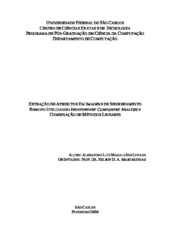Extração de atributos em imagens de sensoriamento remoto utilizando Independent Component Analysis e combinação de métodos lineares
Abstract
Methods for feature extraction represent an important stage in statistical pattern recognition applications. In this work we present how to improve classification performance creating a feature fusion framework to combine second and higher order statistical methods, avoiding existing limitations of the individual approaches and
problems as ill-conditioned behavior, which may cause unstable results during the estimation of the independent components (whitening process) and eventual noise amplifications. The resulting scheme is used to combine features obtained from a variety of methods into a unique feature vector defining two approaches: Concatenated
and Hierarquical Feature Fusion. The methods are tested on both multispectral and
hyperspectral remote sensing images, which are classified using the maxver (maximum
likelihood) approach. Results indicate that the technique outperforms the usual methods
in some cases, providing a valid useful tool for multivariate data analysis and classification.
